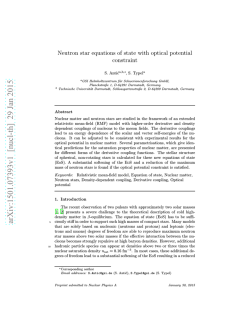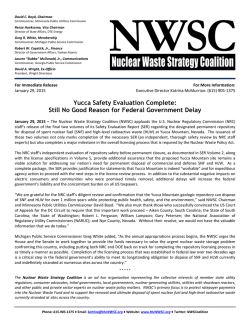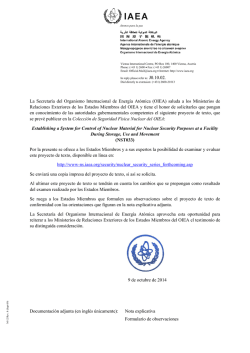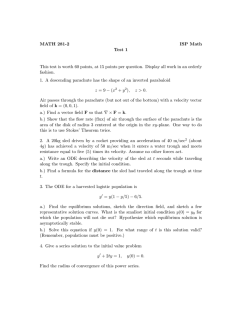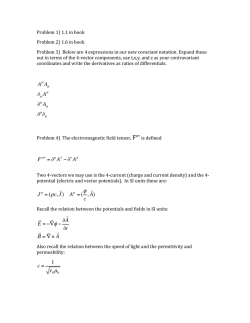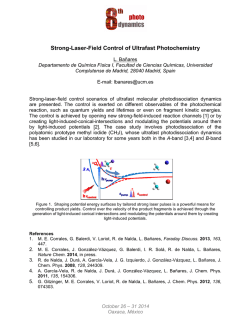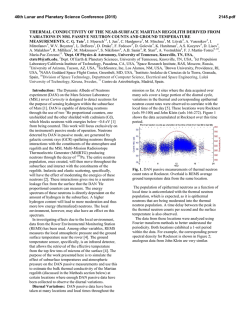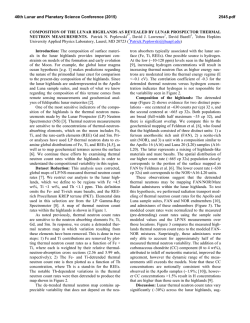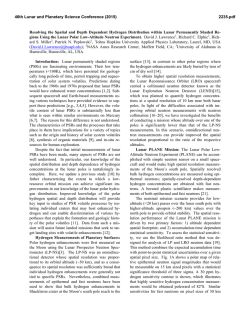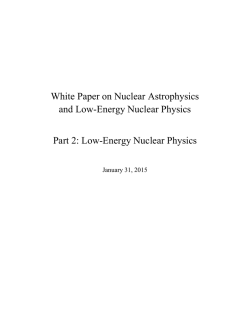
Isospin dependence of nucleon effective mass in Dirac Brueckner
Physics Letters B 604 (2004) 170–174 www.elsevier.com/locate/physletb Isospin dependence of nucleon effective mass in Dirac Brueckner–Hartree–Fock approach Zhong-Yu Ma a , Jian Rong a , Bao-Qiu Chen a , Zhi-Yuan Zhu b , Hong-Qiu Song b a China Institute of Atomic Energy, Beijing 102413, PR China b Shanghai Institute of Applied Physics, Chinese Academy of Sciences, Shanghai 201800, PR China Received 3 September 2004; accepted 3 November 2004 Available online 11 November 2004 Editor: J.-P. Blaizot Abstract The isospin dependence of the nucleon effective mass is investigated in the framework of the Dirac Brueckner–Hartree– Fock (DBHF) approach. The definition of nucleon scalar and vector effective masses in the relativistic approach is clarified. Only the vector effective mass is the quantity related to the empirical value extracted from the analysis in the non-relativistic shell and optical potentials. In the relativistic mean field theory, where the nucleon scalar and vector potentials are both energy independent, the neutron vector potential is stronger than that of proton in the neutron-rich nuclear matter, which produces a smaller neutron vector effective mass than that of proton. It is pointed out that the energy dependence of nucleon potentials has to be considered in the analysis of the isospin dependence of the nucleon effective mass. In the DBHF the neutron vector effective mass is larger than that of proton once the energy dependence of nucleon potentials is considered. The results are consistent with the analysis of phenomenological isospin dependent optical potentials. 2004 Elsevier B.V. All rights reserved. PACS: 21.65.+f; 24.10.Jv; 24.19.Cn; 21.10.Gv Keywords: Nucleon effective mass; Dirac Brueckner–Hartree–Fock approach; Neutron-rich nuclear matter The nucleon effective mass characterizes the propagation of a nucleon in the nuclear medium, which is adopted to describe an independent quasi-particle model in the nuclear many-body system [1,2]. Recently, the radioactive beam physics has become one of the frontiers in nuclear physics. It offers the possi- E-mail address: [email protected] (Z.-Y. Ma). 0370-2693/$ – see front matter 2004 Elsevier B.V. All rights reserved. doi:10.1016/j.physletb.2004.11.004 bility to broaden our understanding of nuclear properties. In the neutron-rich side, one of the most interesting questions is the isospin dependence of the nucleon effective interaction as well as the nucleon effective mass. The knowledge about the isospin dependence of the nucleon effective mass is critically important for understanding properties of neutron stars and the dynamics of nuclear collisions induced by radioactive beams [3–5]. Unfortunately, up to now the knowledge Z.-Y. Ma et al. / Physics Letters B 604 (2004) 170–174 about the isospin dependence of those quantities from experiments is very little. Recently Li [6] studied the constraint of the neutron–proton effective mass splitting in the neutron-rich nuclear matter. He found that an effective mass splitting of m∗n < m∗p leads to a symmetric potential that is inconsistent with the energy dependence of the Lane potential constrained by the nucleon–nucleus scattering experimental data. The purpose of this work is to study the isospin dependence of the nucleon effective mass microscopically in a relativistic approach. It is known that there also exist some confusions on the nucleon effective mass in the relativistic approach [7]. We shall first clarify the definition of the nucleon effective mass in the relativistic approach and, then investigate the isospin dependence of the nucleon effective mass in the Dirac Brueckner– Hartree–Fock (DBHF) approach. In the non-relativistic approach the nuclear microscopic potential V (k, ε) is non-local and of frequency dependence. The effective mass represents the nonlocality of the underlying microscopic nuclear potential. The non-locality of the nuclear potential in the spatial coordinates is usually called k-mass Mk∗ and the dynamic effect of the nuclear potential reflects its energy dependence or non-locality in time, which corresponds to the nucleon effective E-mass ME∗ [1,2]. The effective mass is the product of those two M ∗ /M = Mk∗ /M · ME∗ /M. The nucleon effective mass can be derived by following two equivalent expressions [7], d M∗ = 1 − V k(ε), ε M dε = 1+ M d V k, ε(k) k dk −1 , (1) k=k(ε) where ε(k) is a function of the momentum k defined by the energy–momentum relation, ε = k 2 /2M + V (k, ε). The nucleon effective mass can be determined from analysis of the experimental data performed in the framework of the non-relativistic shell and optical models. The typical value of the nucleon effective mass is M ∗ /M ≈ 0.70 ± 0.05, at ε ≈ 30 MeV, which is obtained by a large body of phenomenological nonrelativistic analyses of experimental scattering data. Recently developed relativistic mean field (RMF) approach is very successful in the description of nuclear ground state properties [8], which becomes a 171 very popular tool in the study of the nuclear structure and nuclear reactions. It is now widely applied in the description of many subjects, such as exotic nuclei, astrophysics as well as heavy nucleus collisions. In the relativistic approach, the nucleon effective mass is always addressed in such a way that the dressed nucleon in the nuclear medium could be described by a Dirac equation. In the Dirac equation the nucleon effective mass is largely reduced by the nucleon attractive scalar potential in the nuclear medium Ms∗ = M + Us , (2) where Us is the nuclear scalar potential, which is attractive. Ms∗ , M are the nucleon effective and bare mass, respectively. The nuclear scalar potential in the RMF is about Us = −375 ± 40 MeV, which corresponds to Ms∗ /M = 0.60 ± 0.04 [8]. However, this definition of the effective mass is not directly related to the same empirical value derived from the analysis of experimental data in the non-relativistic shell and optical models, as described above. Actually the definitions in Eqs. (1) and (2) denote different physical quantities. This confusion has already been pointed out and clarified by Jaminon and Mahaux [7] many year ago. We may call this nucleon effective mass defined in Eq. (2) the scalar effective mass or Dirac mass [9]. In order to compare a same quantity in the non-relativistic and relativistic approaches one derives a Schroedinger equivalent equation for the upper component of the nucleon Dirac spinor by eliminating the lower component. The Schroedinger equivalent central potential could be expressed as Vcen = Us2 − U02 + 2EU0 + 2MUs /2M, (3) where U0 is the nucleon vector potential [8] and E = ε + M is the nucleon energy in the relativistic approach. The Schroedinger equivalent central potential plays the same role as the potential V (ε) in the nonrelativistic approach. Therefore, the non-relativistictype effective mass as defined in Eq. (1) can be derived in a similar way [7]. In the RMF the nucleon scalar and vector potentials are energy independent, which yields Mv∗ /M = 1 − U0 /M. (4) This effective mass may be called the vector effective mass of the nucleon or Lorentz mass [7], which characterizes the energy dependence of the Schroedinger 172 Z.-Y. Ma et al. / Physics Letters B 604 (2004) 170–174 equivalent central potential. Although it does not imply that any non-relativistic limit has been taken, this definition of the effective mass could be compared with the empirical value extracted from the analysis of the shell and optical models. In the RMF theory the isospin dependence of the nucleon self-energy is obtained through the exchange of the isovector meson ρ, which produces a stronger vector potential for neutron than that for proton in the neutron-rich nuclear matter and keeps same scalar potentials for neutron and proton. Therefore in the RMF one obtains Ms∗ (N) = Ms∗ (P ) and M ∗ (N) < M ∗ (P ) in the neutron-rich nuclear matter. If one introduces the isovector scalar meson δ in the RMF, which produces a more attractive scalar potential for neutron, even the neutron scalar effective mass is smaller than that of proton in the neutron-rich nuclear matter. However, it is well known that the microscopic nuclear scalar and vector potentials are of the momentum and energy dependence. Taking account of the energy dependence of the nucleon scalar and vector potentials, the vector effective mass of a nucleon is now obtained as follows, Mv∗ /M = 1 − U0 /M − (1 + Us /M) dUs /dε − (1 + ε/M − U0 /M) dU0 /dε. (5) In order to consider the energy dependence of the nucleon self-energy in the nuclear medium we shall study microscopically the nucleon scalar and vector potentials in an asymmetric nuclear matter (ASNM) in the DBHF approach. Recently, a new decomposition of the Dirac structure of nucleon self-energies in the DBHF was proposed by Schiller and Müther [10, 11]. The DBHF G matrix was separated into a bare nucleon–nucleon (NN) interaction V and a correlation term G. The bare NN interaction is described by meson exchanges, such as one boson exchange potentials (OBEP). The coupling constants and meson masses are determined by experimental phase shifts of the NN scattering and the ground state properties of the deuteron, which are fixed in the DBHF approach. A projection method is applied only on the correlation term G and it is parameterized by four pseudomesons. Therefore the effective NN interaction G in the DBHF in the symmetric nuclear matter (SNM) and the ASNM can be characterized by the exchanges of those mesons in the relativistic Hartree–Fock approach. Ma and Liu [12] and Rong and Ma [13] have used this scheme to analyze properties of the ASNM and finite nuclei as well as nuclear optical potentials. Reasonable results are achieved. In this work the same scheme is adopted to investigate the effective mass of proton and neutron in the ASNM. In consistent with the rotational invariance of the infinite nuclear matter, the self-energy of proton and neutron can be written as Σ i (k) = Σsi (k) − γ0 Σ0i (k) + γ · kΣvi (k), Σsi , (6) Σ0i where i denotes proton and neutron, and Σvi are the scalar component, time-like and space-like parts of vector components of the nucleon self-energy, respectively. The nucleon self-energy in nuclear matter in the DBHF approach can be calculated with a bare NN potential V and parameterized G Σ(k) = α d 4q (2π)4 b × Γαa ∆ab α (0) Tr iΓα G(q) b − iΓαa ∆ab α (q)Γα G(k − q) , (7) where the first and second terms are Hartree and Fock terms, respectively. The index α refers to mesons, a and b refer to isospin components. G is the single particle Green’s function, and ∆ab α are meson propagators. The vertex Γαa is expressed as: ig for scalar f 5 µ γ γ qµ for mesons, −gγ µ for vector mesons and − m pseudoscalar mesons, respectively and multiplied by an isospin operator τα for isovector mesons. The nucleon propagator G can be divided into two parts: the Feynman part GF and density-dependent part GD . The GF produces a divergent vacuum tadpole on the nucleon self-energy, which is neglected in the DBHF calculation. The density-dependent part GD is expressed as iπ GD (k) = Ti γ µ kµ + M ∗ (k) ∗ E (k) × δ k0 − ε(k) θ kF − |k| . (8) Ti is the isospin part of the propagator: 1 Ti = (1 ± τ3 ), (9) 2 where the plus and minus index correspond to proton and neutron, respectively. The Dirac equation of a nucleon in the nuclear medium has the form α · p + γ0 M + Usi + U0i ψ i (r) = εi ψ i (r), (10) Z.-Y. Ma et al. / Physics Letters B 604 (2004) 170–174 173 where Usi and U0i are scalar and vector potential, respectively, which are modified by the space-like vector potential Σiv Usi = Σsi − MΣvi , 1 + Σvi U0i = −Σ0i + εi Σiv . 1 + Σiv (11) In the ASNM, one defines an asymmetric parameter β= ρn − ρp , ρn + ρp (12) where ρn and ρp denote densities of neutron and proton, respectively. This implies that the SNM corresponds to β = 0 and pure neutron matter to β = 1.0. The nucleon self-energy in the ASNM can be calculated in the DBHF. In this work the bare NN interaction is taken as Bonn B [14]. The isospin dependence of the relativistic optical potential in the DBHF has been investigated in Ref. [15], which was consistent with the phenomenological Lane potentials extracted from the experimental data of (p, n) reactions [16]. The nucleon scalar potential Us and vector potential U0 of proton and neutron in the SNM and the ASNM with β = 0.3 at kF = 1.36 fm−1 as functions of the energy are plotted in Fig. 1(a). In the SNM, it is found that Us is about −336 MeV and U0 = 256 MeV at the Fermi surface, which correspond to the nucleon scalar effective mass, Ms∗ /M = 0.64 at the Fermi surface and the vector effective mass, Mv∗ /M = 0.73 if one neglects the energy dependence of the nucleon self-energy. These results are consistent to those obtained in Ref. [12] and cited therein. Both nucleon scalar and vector potentials decrease as the nucleon incident energy increases. In the neutron-rich nuclear matter the neutron self-energy, both scalar and vector potentials become stronger than those of proton due to the larger neutron density, while the difference of neutron and proton vector potentials is much larger than that of scalar potentials. Therefore the phenomenological coupling constant of the isovector–scalar meson δ is usually taken to be rather weak or simply omitted in the RMF. Although the energy dependence of nucleon potentials is not strong, the energy dependence of neutron scalar and vector potentials are steeper than those of proton, especially for the vector potential. In the Fig. 1(b) we plot those potentials as functions of the asymmetry parameter β at nucleon incident energies ε = 0 and 50 MeV. In the neutron-rich nuclear matter Fig. 1. Nucleon scalar potentials Us and vector potentials U0 of proton and neutron in the ASNM at kF = 1.36 fm−1 as functions of the energy (a) and the asymmetry parameter (b). neutron vector potentials become much stronger than those for proton. Nucleon effective masses are calculated with those nucleon potentials by Eqs. (3) and (5). The results are shown in Fig. 2, where upper and lower curves correspond to nucleon scalar and vector effective masses, respectively. The solid (dashed) curves are those of neutron (proton). It is obviously that the neutron scalar mass is smaller than that of proton in the neutron-rich nuclear matter due to the stronger scalar potential of neutron. However, the difference of neutron and proton scalar effective masses is very small in the neutronrich nuclear matter. It is found that the energy dependence of the nucleon self-energy largely reduces the nucleon vector effective mass. At the nucleon energy ε = 50 MeV, the nucleon scalar and vector effective 174 Z.-Y. Ma et al. / Physics Letters B 604 (2004) 170–174 Acknowledgements This work is supported by the National Natural Science Foundation of China under Grant Nos. 10275094, 10475116, and 10235020, and the Major State Basic Research Development Programme of China under Contract No. G2000077400. M.Z.Y. and C.B.Q. would like to thank the hospitality of the Theory group, Shanghai Institute of Applied Physics, PR China. This work was initialized during their visit. This work has also been supported in part by the Knowledge Innovation Project of Chinese Academy of Sciences under grant No. KKCX2-N11. Fig. 2. Nucleon scalar and vector effective masses at E = 50 MeV in the asymmetric nuclear matter with kF = 1.36 fm. References masses in the SNM are 0.66 and 0.68, respectively. Due to the stronger energy dependence of the neutron vector potential the neutron vector effective mass become larger than that of proton in the neutron-rich nuclear matter. This result is consistent with the microscopic many-body theories in the non-relativistic approach, e.g., the Landau–Fermi liquid theory [17] and the BHF approach [18] as well as the energy and isospin dependence of the nucleon–nucleus scattering experimental data [6]. In summary, we have clarified the definition of the nucleon scalar and vector effective masses in the relativistic approach, where only the nucleon vector effective mass could be compared with that in the nonrelativistic approach. The nucleon effective mass defined in the non-relativistic approach could be compared with the empirical value extracted from the analysis of the shell and optical models. The isospin dependence of the nucleon vector effective mass is calculated in the DBHF in the ASNM. It is found that the neutron vector effective mass is larger than that of proton in the neutron-rich nuclear matter if the energy dependence of the nucleon self-energy is taken into account. This result is consistent with what was found in the microscopic studies of non-relativistic approach. [1] J.P. Jeukenne, A. Lejeune, C. Mahaux, Phys. Rep. 25 (1976) 83. [2] C. Mahaux, P.F. Bortignon, R.A. Broglia, C.H. Dasso, Phys. Rep. 120 (1985) 1. [3] J. Rizzo, M. Colonna, M. Di Toro, V. Greco, Nucl. Phys. A 732 (2004) 202. [4] M. Farine, et al., Nucl. Phys. A 696 (2001) 396. [5] B.A. Li, C.B. Das, D. Gupta, C. Gale, nucl-th/0312054, Nucl. Phys. A (2004), in press. [6] B.A. Li, nucl-th/0404040. [7] M. Jaminon, C. Mahuax, Phys. Rev. C 40 (1989) 354. [8] P. Ring, Prog. Part. Nucl. Phys. 37 (1996) 197. [9] L.S. Celeza, C.M. Shakin, Relativistic Nuclear Physics: Theory of Structure and Scattering, World Scientific, Singapore, 1986. [10] E. Schiller, H. Müther, Eur. Phys. J. A 11 (2001) 15. [11] S. Ulrych, H. Müther, Phys. Rev. C 56 (1997) 1788. [12] Z.Y. Ma, L. Liu, Phys. Rev. C 66 (2002) 024321. [13] J. Rong, Z.Y. Ma, Sci. China G 33 (2003) 481. [14] R. Machleidt, Adv. Nucl. Phys. 19 (1986) 189. [15] J. Rong, PhD thesis, China Institute of Atomic Energy, PR China, 2004. [16] A.M. Lane, Phys. Rev. Lett. 8 (1962) 171; A.M. Lane, Nucl. Phys. 35 (1962) 676. [17] O. Sjöberg, Nucl. Phys. A 265 (1976) 511. [18] I. Bombaci, U. Lambardo, Phys. Rev. C 44 (1991) 1892; W. Zuo, I. Bambaci, U. Lambardo, Phys. Rev. C 60 (1999) 24605; W. Zuo, A. Lejeune, U. Lambardo, J.F. Mathiot, Eur. Phys. J. A 14 (2002) 469.
© Copyright 2026
